Emile Salmson
Salmson are arguably best remembered for their 35 years as car manufacturers who produced some of the more distinctive touring and sporting designs of the period between the wars. At the turn of the century, Emile Salmson owned a factory in the Rue de la Grange-aux-Belles, Paris XIe, where he built pumps for light industry. However, he was always ready to branch out into new fields, and was one of the early pioneers of aviation in France, building an unsuccessful helicopter before 1910.
The Societe des Moteurs Salmson
Emile Salmson realised that one of the main problems facing aircraft constructors was the lack of suitable power units, so when the opportunity came to acquire a licence to manufacture the Canton-Urine radial aero engine, Salmson lost no time in setting up a company called the Societe des Moteurs Salmson. The works of the new company were at 3 Avenue des Moulineaux, Billancourt, not far from the Issy flying ground where seven and nine-cylinder radial engines were built during the war.
Another profitable sideline was the manufacture of magnetos, and by the end of the war Salmson employed 6000 workmen at Billancourt. There was also a subsidiary factory at Lyon-Villeurbanne, with another 1000 workmen. After Emile Salmson died in 1917, and his sons left the company in 1919, the directorship passed to M. Heinrick, formerly head of the Lyon factory. Among the projects considered for peacetime were sewing machines and typewriters but the company eventually settled on woodworking machinery, the manufacture of valves, civil aircraft engines, and cars.
Salmson GNs
The obvious thing to do was to acquire a licence to manufacture an existing design. The English GN, one of the better cyclecars, was chosen and a three year licence signed in June 1919; Salmson GNs were in production three months later. Salmson took a stand at the Paris Salon in October 1919, ostensibly to show magnetos and accessories, but more accurately to circumvent the stipulation that all motor manufacturers showing at the salon should have been established at least six months. In fact, Salmson cleverly created publicity for their product by parking strikingly finished GNs around the Grand Palais.
Emile Petit
Though the Salmson-Glv was tres bon marche, its low price and reasonable performance were not the irresistible combination hoped for. Andre Lombard, the sales agent who had been influential in the design choice began casting around for a more substantial alternative. An aacquaintance of his, the engineer Emile Petit, had recently established a design office in Paris, where he had drawn up an ingenious small engine based on his wartime aero engine experience. Lombard persuaded Petit to instal one of these power units, an air-cooled 1086cc four-cylinder (coincidentally the same swept volume as that of the GN's vee-twin engine) in a chassis for presentation to the Salmson management as a possible prototype for future production.
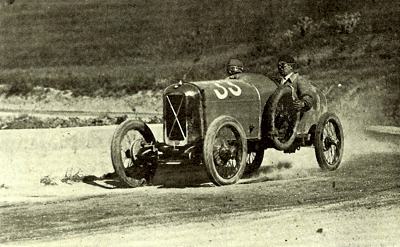 A Salmson (driver unknown) in the Targa Florio during the early 1920's.
A Salmson (driver unknown) in the Targa Florio during the early 1920's.
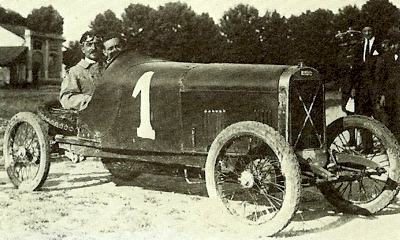 Abele Clerici poses in his 1100cc Salmson at Cremona in 1924.
Abele Clerici poses in his 1100cc Salmson at Cremona in 1924.
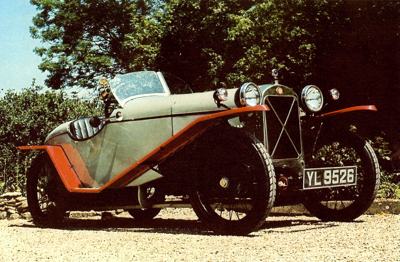 1926 Salmson GS, powered by a twin-overhead-camshaft 1086cc engine driving through a three-speed gearbox.
1926 Salmson GS, powered by a twin-overhead-camshaft 1086cc engine driving through a three-speed gearbox.
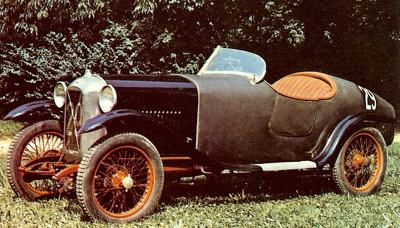 1927 Competition Salmson, powered by a 1100cc twin overhead cam engine.
1927 Competition Salmson, powered by a 1100cc twin overhead cam engine.
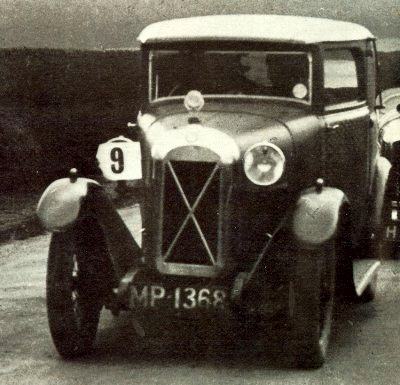 1928 Salmson 65 Sports Coupe competing in the Ilkley Club Trial.
1928 Salmson 65 Sports Coupe competing in the Ilkley Club Trial.
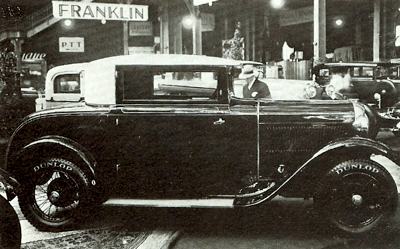 1929 Salmson S4 two-door coupe, powered by a 1300cc four-cylinder engine.
1929 Salmson S4 two-door coupe, powered by a 1300cc four-cylinder engine.
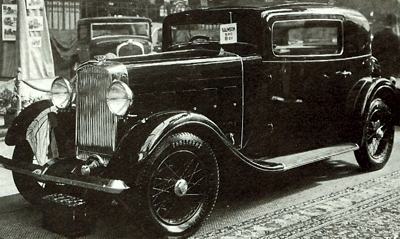 1932 Salmson S4.
1932 Salmson S4.
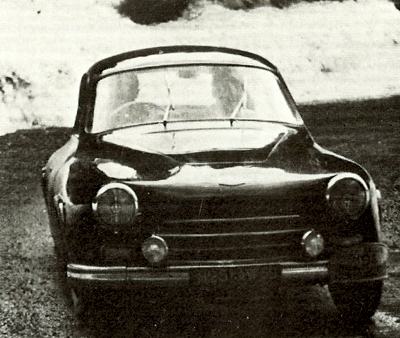 1953 Salmson G72 in action. This model would win several rally's, this picture is from the 1954 Lyon Charbonnieres rally.
1953 Salmson G72 in action. This model would win several rally's, this picture is from the 1954 Lyon Charbonnieres rally. |
The Swiss Six Days Trial
Within three months, the vehicle was complete: the Salmson directorate approved it, save for the cooling system. The engine was aircooled, and they had obviously had enough of this system with the GN, as they were insistent that watercooling must be standardised. So Petit set to work and designed a watercooled cylinder block for the engine; which was put to a severe test in August 1921, an entry for Lombard in the Swiss Six Days Trial alongside a Salmson-GN driven by the firm's recordman, Honel, who had taken the Championnat de France (Tourisme) for his performance with GNs the previous year.
The Swiss event was primarily a motorcycle trial, but nevertheless Lombard (and Honel) won a gold medal. The engine which had carried off the honours on its first outing was somewhat unorthodox in concept: it had overhead valves, but only one pushrod to each pair of inlet and exhaust valves. A rocker bridged the two valve stems, operating the far one in the conventional manner on the up stroke of the push rod. When, however, the cam went over-centre, the foot of the pushrod dropped into a recess in the cam, and tension springs forced the near end of the rocker down, opening the other valve. This monoculbuteur power unit had a two-bearing crankshaft and splash lubrication, and was mounted in unit with a three-speed and reverse gearbox of conventional design instead of the chain-and-dog of the GN.
The Grand Prix des Cyclecars at Le Mans
But
Petit had something even more unusual in hand, in the shape of a twin overhead camshaft version of his power unit, with desmodromic valve operation. This was a remarkable development for 1922, and quite unexpected from a manufacturer of cycle-cars, as the twin ohc engine was still regarded as the province of high power racing machinery developed at vast expense. Just like the monoculbuteur, the new ohc engine proved itself first time out. On 16 September 1921, Lombard won the Grand Prix des Cyclecars at Le Mans, averaging 54.6 mph round the Circuit de la Sarthe despite running out of petrol three laps from the end.
The Cross of St Andrew
In honour of this victory, the cross of St Andrew (for Andre Lombard) was added to the radiator grille. Although the twin ohc model had made such an outstanding debut, a production derivative did not become available until 1923: meanwhile it was the monoculbuteur (now known as the Type AL, again after Andre Lombard) which was to form the basis of Salmson output. The GN was rapidly phased out, and the last of this model appears to have been built at Billancourt during the summer of 1922. However, after Salmson had stopped making them, GNs were still imported from England by Thevenet and Giovanelli, who modified them according to French taste.
The Salmson Modele-Sport
A full range of Type AL Salmsons was shown at the 1921 Paris Salon: a two-seater 'tourisme' priced at 8900 Francs, a voiturette, a three-seated 'torpedo', a landaulet, a saloon, a delivery van and a pickup truck were offered, but the car which was to typify the vintage Salmson to so many drivers also made its bow, the 9900 Franc Modele-sport, with exiguous coachwork which came to a derriere de canard point at the rear. Standard equipment of the Salmson was very sketchy, even the spare wheel was an extra: but there was a very valid reason why - it was necessary for the Salmson to shed all unnecessary weight so that it would qualify as a cyclecar for taxation purposes. Once having had his Salmson officially weighed, the proud owner was at liberty to fit as many extras as he liked (probably ordered at the same time as the car, though separately invoiced and delivered of course).
In the further interests of lightness, the chassis ended at the mountings for the rear quarter-elliptic springs, so that aft of that point the coachwork had to be self-supporting, hence the somewhat sad droop-tailed look of some elderly Salmsons. There were, apparently, only four of the desmodromic twin ohc racers built, and for the 1922 season these, fitted with fuselage-styled bodies which recalled Salmson's aerial activities, recorded class wins in the Brooklands 200-mile Race and the Cyclecar GP, while that October Lombard set up a 95 mph class record in the Bois de Boulogne with a streamlined single-seat body fitted to his car.
The 1922 Paris Salon
Twin ohc examples went into production with the announcement of the 1250cc 10 hp Salmson at the 1922 Paris Salon. This was a proper light car, and had half-elliptic front springs and a curious patented rear suspension by pairs of quarter elliptic springs, one pair facing rearwards in the conventional manner, the other forward. Surprisingly, Salmson did not mention the overhead cams in their showtime advertising, but they did note that the 10hp had front-wheel-braking. It was probably the first twin ohc touring car offered commercially. The Type D never sold particularly well: total production in six years was around 1100, and the majority of these were sold in the model's first three years.
On the sporting side there were class wins in the 200 Miles Race and the Cyclecar Grand Prix, while a one-off 750cc racer was also successful in taking its class in the Cyclecar GP, driven by M. Lombard, who was shortly to leave Salmson to set up on his own (but the St Andrew's Cross and the AL designation were to remain for some time longer). Finances for the competitition department were sadly lacking in 1924, and the company took an enforced sabbatical year on the sporting side as a result. Yet there were still victories without works support, even for the 1922 twincam racers, which were driven in the Brooklands 200 by Zborowski, Hawkes and Wilson-Jones. The first two retired, but Wilson-Jones took the expected class victory.
The Chassis Forme Salmson GS and SS
Performance capabilities of the AL series had always been quite surprising, and the sports variants came to typify the name Salmson. As performance rose, the chassis design became more robust. The first step was the adoption of semi-elliptic front suspension for the AL series, which now became Type V AL3; this happened in 1925, while a year later came what was euphemistically known as a 'chassis forme'. In other words, a crossmember was added to the rear of the chassis to prevent the bodywork from sagging. In 1926 Salmson adopted the twin ohc versions of the 1086 cc engine for sports Salmsons, under the designations 'GS' and 'SS', the main difference being that the GS had a three-speed gearbox, while the SS was a four-speeder, and had three-bearing cranks and semi-pressure lubrication.
It also seems that the British agents fitted a small number of twin-cam engines in chassis intended originally for the monoculbuteur unit. Most common of these sporting Salmsons was the GS (sold in Britain under the name Grand Prix, which in France was reserved for a special series of 18 cars built in 1928, and equipped with Cozette superchargers). Other variations included the hotted-up San-Sebastian engine, and the GS8 lowered chassis, both dating from 1928, but by then, the era of the Petit sports cars was nearing its end. His last design for the company was a straight-eight racer with desmodromic valve gear, which appeared in 1929: but only two were built, and they were never given a chance to develop their full potential.
British Salmson
Salmson's first non-Petit design was the S4, which appeared in the autumn of 1929. Still with twin ohc, it had a swept volume of 1300cc and a three-speed gearbox, though its performance was usually stultified by saloon or coupe coachwork. The new models had radiators and badges created by the Art Deco designer Andre Kow: but this Andre did away with the traditional St Andrews Cross. It was to reappear, however, in anglicised guise, on some of the British Salmson cars of 1934-39, based on the S4C of 1931/1932, which had a 1465 cc engine. The only difference between the British Salmson, built by British Salmson Aero Engines Limited at Raynes Park, and the parent model (apart from coachwork) was that the British car had a synchromesh gearbox, while the French S4D could boast a Salmson-built Cotal electrically-operated transmission as standard on the 1600cc S4D which formed the basis of production on both sides of the Channel from 1936.
Some S4Ds had a bored-out engine of 1730cc, the modification of which became crystallised as the S4DA, with a longer and much lower chassis in 1937. Other features of the S4D were its independent front suspension and rack-and-pinion steering, while the British Salmson S4D also boasted hydraulic brakes. Late in 1935 the British Salmson company introduced a new model unique to the British market, the 20/90 sports, which carried the revived St. Andrew's Cross on its radiator grille. Apart from being the first Salmson car to feature independent front suspension, the 20/90 was also the only six-cylinder Salmson, with a swept volume of 2590cc. Only limited production of this model was undertaken, and by 1939 the 20/90 was the only British Salmson model, the company having reverted to importing French Salmson chassis, doubtless aided by the 1936 devaluation of the franc.
Enlaidissement des Carrosseries
There were plans to build the S4E, a 2.3-liter long-stroke model introduced in France in 1937, at Raynes Park, but they came to nothing, and eventually British Salmson abandoned cars altogether, turning to general precision engineering. In France, Salmson resumed production in 1946 with the 2.3-Iitre S4E and the 1.7-liter S4-61 which had constituted their 1939 line-up. Unfortunately the company then went in for what one French authority has called 'enlaidissement des carrosseries' - 'uglification of bodywork'. A new car called the Randonnee appeared in 1951, powered by a light-alloy version of the old faithful 2.3-Iitre S4E engine. It is recorded that production of this model was 'feeble'. A handsome GT car, the G72 appeared in 1953, and proved that its performance was as good as its styling by an impressive total of rally wins in the 1954 season. In 1956 there were plans for a long-wheelbase four-door version of the G72, but they got no further than the prototype stage, and in 1957 Salmson quietly retired from car production.
